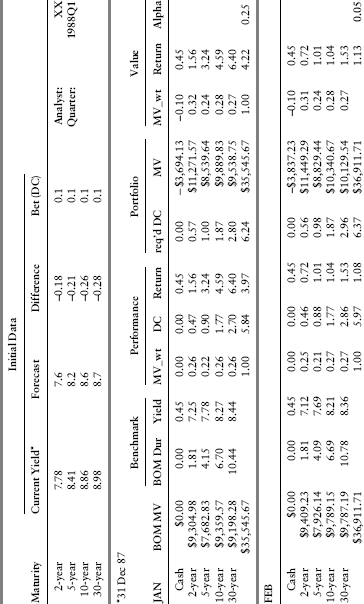A Bond Portfolio Strategy (Optional)
Bond managers typically make yield curve bets based on their perceptions of general movements in the yield curve over the portfolio-holding period (Peterson and Gardiner 2006). Portfolios are typically formed on the basis of these expectations and rebalanced monthly to reflect both changes in realized yields as well as expectations revisions.
At the beginning of each quarter, we construct a bond portfolio (the active portfolio) consisting of 2-year, 5-year, 10-year, and 30-year Treasury securities reflecting a yield curve bet based on current one-step ahead forecasts at each of these four points on the yield curve. The so-called benchmark portfolio is also constructed from the same four Treasury securities. Our desire is that the active portfolio adds value over the benchmark portfolio (see Chapter 10 on active management for a deeper explanation). Our strategy is this: if the current quarter yield is forecasted to fall (rise) relative to the last observed yield for a specific on-the-run (OTR) security, then the portfolio takes a long (short) position in that bond.
Each bond's weight in the portfolio is a function of relative yield curve duration (using the beginning of month [BOM] durations) and BOM market value of the OTR bonds. Appropriate OTR securities for each month were obtained through Lehman Brothers along with relevant information for each security, such as month-end price, yield, modified duration, and total return. Citigroup provided the 30-day Treasury bill return (to proxy the return on cash) and the amount outstanding for each security for each month that was pulled from the Bureau of Public Debt website.
Both the active portfolio and the benchmark portfolio were rebalanced in subsequent months of each quarter. This particular benchmark eliminates the performance impact due to risk factors other than interest rate risk (for example, credit or prepayment risk). The portfolio holds the benchmark securities plus a long or short cash position as needed to maintain proper interest rate exposure. There are no transactions costs. The performance measure is the monthly gross return of the portfolio over the benchmark (we call this the active return, or alpha).
A typical portfolio evaluation example is presented below in Table 2.8 for the first quarter 1988. The top of the table lists the latest observed yields (end of month yields for December 1987) and the analyst's initial forecasts for the upcoming quarter. Our fictional client calculates the forecasted change in the yield and makes a tenth of a year duration bet, that is, takes a long or short position of duration 0.1 for each security in the portfolio relative to the benchmark. From the BOM market values, he then calculates the market value weights (MV_wt). The benchmark return for January 1988 is simply the sum of the market value weighted end-of-month observed returns (for example, ![]() ).
).
Table 2.8 Portfolio Construction Example.


The individual duration contributions (DC) required to place the desired bet at each point on the yield curve are also calculated from the market value weights as DC = (MV_wt) × BOM duration). The portfolio return for January 1988 is based on the required duration contribution, which is the observed duration contribution (DC), plus the duration contribution bet (0.1). The portfolio holdings consist of the BOM market value ($35,546) allocated across securities with weights given by the relative required DC, that is, the required DC divided by the BOM duration. For example, the portfolio invests ![]() in the two-year note to increase the duration contribution from 0.47 to 0.57 to reflect a long duration bet on this point on the yield curve (the analyst in this case forecasted the yield to fall). The short cash position is required because the portfolio is overexposed relative to the benchmark due to the expected decline in the yield curve. The new market value weights reflect the increase in the required duration contribution and, using these, the month's return to the portfolio (4.22 percent) can be compared to the benchmark return (3.97 percent) to arrive at the alpha (0.25 percent).
in the two-year note to increase the duration contribution from 0.47 to 0.57 to reflect a long duration bet on this point on the yield curve (the analyst in this case forecasted the yield to fall). The short cash position is required because the portfolio is overexposed relative to the benchmark due to the expected decline in the yield curve. The new market value weights reflect the increase in the required duration contribution and, using these, the month's return to the portfolio (4.22 percent) can be compared to the benchmark return (3.97 percent) to arrive at the alpha (0.25 percent).
